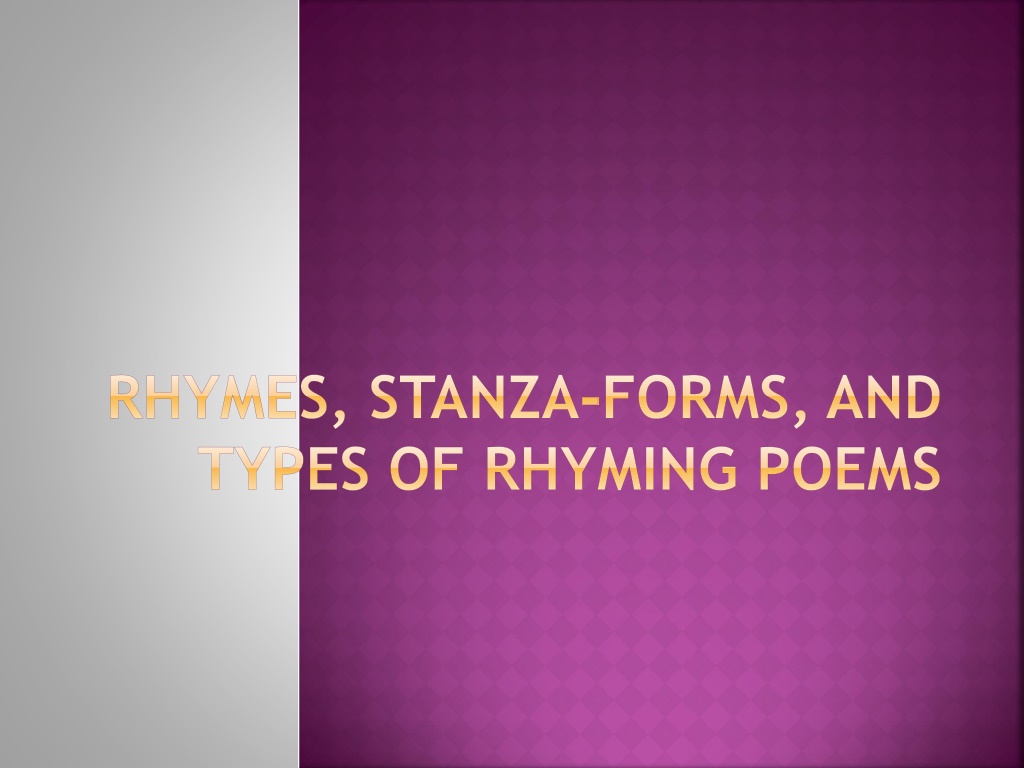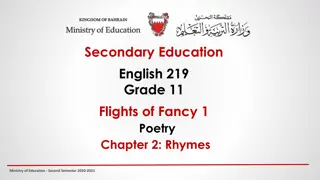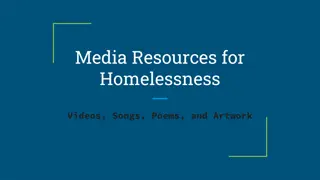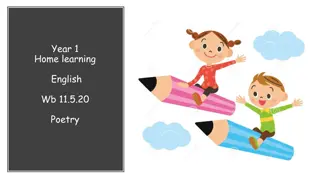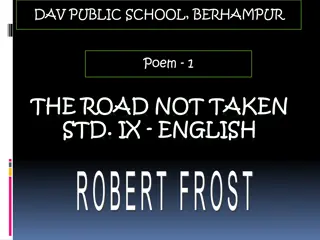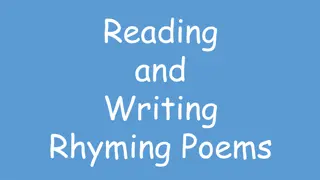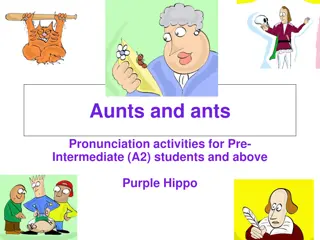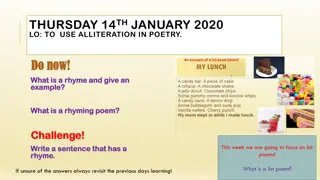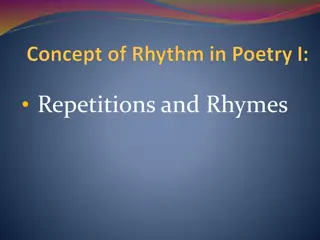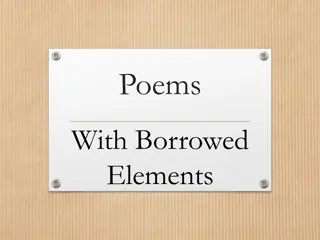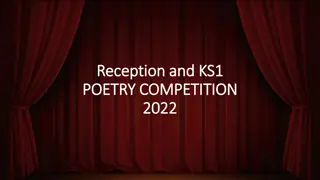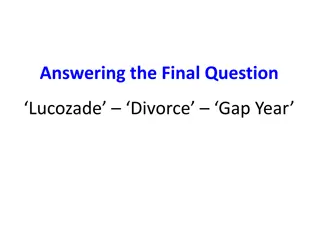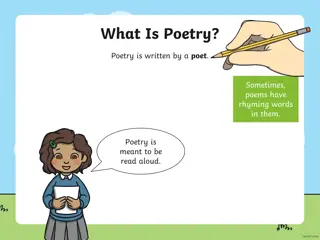Understanding Rhymes, Stanza Forms, and Types of Rhyming Poems
Explore the world of rhymes through couplets, tercets, quatrains, sixains, and sonnets. Learn about different stanza forms and types of rhyming poems like Italian sonnets and the structure of a sonnet. Unveil the beauty and complexity of poetic composition in various rhyming schemes.
Download Presentation

Please find below an Image/Link to download the presentation.
The content on the website is provided AS IS for your information and personal use only. It may not be sold, licensed, or shared on other websites without obtaining consent from the author. Download presentation by click this link. If you encounter any issues during the download, it is possible that the publisher has removed the file from their server.
E N D
Presentation Transcript
RHYMES, STANZA-FORMS, AND TYPES OF RHYMING POEMS
RHYMES A pair of rhyming lines is called a couplet. Couplets are frequently run together, not separated as stanzas. While the plowman near at hand, Whistles o er the furrowed land The heroic couplet is an iambic pentameter couplet that is end stopped (marked by a heavy pause) and frequently pointed and witty. The hungry judges soon the sentence sign And wretches hang that jurymen may dine
RHYMES A stanza of three lines is called a tercet: Light the first light of evening , as in a room, In which we sit, and for small reason, think The world imagined is the ultimate good Terza rima is a form of pentameter tercet with interlinked rhymes (aba bcb cdc and so on)
RHYMES A stanza of four lines is called a quatrain. The commonest quatrain is the ballad stanza, in which the first and third lines are unrhymed and have four beats, while the second and fourth lines rhyme and have three beats. It is an ancient Mariner And he stoppeth one of three. By thy long grey beard and glittering eye, Now wherefore stopp st thou me?
RHYMES A stanza of 6 lines is called a sixain or a sestet. The only common seven-line stanza is rime royal ( after King James I) iambic pentameter rhyming ababbcc)
TYPES OF RHYMING POEMS The sonnet is a 14 lines pentameter poem. There are two forms: Italian (Petrarchan) sonnet consists of an octave and a sestet. The first 8 lines rhyme abbaabba, and the last 6 rhyme cdecde. Who will in fairest book of Nature know How Virtue may best lodged in beauty be, Let him but learn of Love to read in thee, Stella, those fair lines which
THE SONNET As with many poems, the structure of the sonnet reflects the content. 1stquatrain: presents a problem or situation 2ndquatrain: gives examples of problem 3rdquatrain: solution or resolution Couplet: solution/resolution/advice
The villanelle is a French form with five petameter tercets rhyming aba, followed by a pentameter quatrain rhyming abaa. This poem intentionally repeats entire lines. Do Not Go Gentle into That good Night by Dylan Thomas
An Ode in English is usually a stanzaic poem, but it has no set form. An ode is defined by its content: it is a poem of a lofty or sublime sort, often using the figure of speech called apostrophe, which is an address to some divine or quasi-divine person or thing (usually absent). Keats Ode to a Grecian Urn
BLANK VERSE The most common form of counted unrhymed verse is blank verse. This is the verse of Shakespeare s plays and of Milton s epic poem, Paradise Lost: That space the evil one abstracted stood From his own evil, and for the time remained Stupidly good, of enmity disarmed, Of guile, of hate, of envy, of revenge.
Who will in fairest book of Nature know How Virtue may best lodged in beauty be, Let him but learn of Love to read in thee, Stella, those fair lines which true goodness show. There shall he find all vices overthrow, Not by rude force, but sweetest sovereignty Of reason, from whose light those nightbirds fly, That inward sun in thine eyes shineth so. And, not content to be Perfection s heir Thyself, dost strive all minds that way to move, Who mark in thee what is in thee most fair. So while thy beauty draws the heart to love, As fast thy Virtue bends that love to good. But ah, Desire still cries, give me some food.
The English (Shakespearean) sonnet consists of three four line quatrains, alternately rhymed and a couplet. Let me not to the marriage of true minds Admit impediments. Love is not love Which alters when it alteration finds, Or bends with the remover to remove: O no; it is an ever-fixed mark, That looks on tempests, and is never shaken; It is the star to every wandering bark, Whose worth's unknown, although his height be taken. Love's not Time's fool, though rosy lips and cheeks Within his bending sickle's compass come; Love alters not with his brief hours and weeks, But bears it out even to the edge of doom. If this be error and upon me proved, I never writ, nor no man ever loved
FREE VERSE Free verse verse in which the lines are of different widths (meter) and which does not rhyme in any regular way was invented by poets who had been brought up on rhymed and counted verse. Most poets who write in free verse reside in the 20th century or later. Free verse poetry must justify its reasons fro breaking a line here rather than there (rhyme or meter usually justifies counted verse)
THE RED WHEELBARROW BY WILLIAM CARLOS WILLIAMS So much depends upon a red wheel barrow glazed with rain water besides the white chickens
